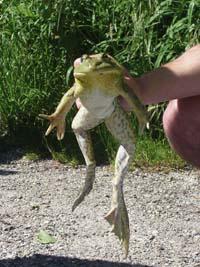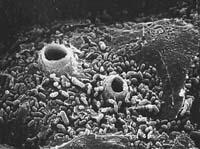New amphibian diseases

New diseases are those that have recently emerged or that have significantly increased their area of influence in recent years. In the case of amphibians, these diseases have a viral or fungal origin, and although at the moment we hardly know anything about them, it seems that the vector that is spreading all over the world at high speed is the human being.
The viruses that affect amphibians are very persistent and easily contaminated. They appear mainly in degraded areas where reproductive amphibians accumulate. The symptoms of the disease are complicated, and although many individuals die without significant external signs, others experience local bleeding, skin ulcers and acute necrosis in the internal organs. In addition, in some cases, secondary infections caused by bacteria produce red leg syndrome, with noticeable blood loss and redness. Some of these viruses also affect fish, so many times the viruses reach the natural environment with repopulations of fish.
Killer mushroom

Viruses are not, however, solely responsible for mass amphibian extinctions; current data suggest that some of the fungi found recently constitute a more serious threat. Batrachochytrium dendrobatidis is a fungus that affects amphibians, a kind of chitridium. The Kitridu group, long known throughout the world, is located in any area. Due to their sensitivity to pollution, they are mainly located in well-preserved areas. Until recently they were only known as parasites of plants, algae, protists and invertebrates, but this new species is deadly for amphibians.
Affected amphibian populations usually disappear within a few months, following the pattern of infectious disease expansion. The cause of the death of infected animals is not yet known, but the development of the disease, chitridiomycosis. When zoospores (mobile spores with scourge) come into contact with amphibians, they are fixed on the keratin of their skin and, in a few days, they develop mature sporangios that create new zoospores. Zoospers are released by a discharge tube that pierces the skin of the contaminated animal. In this way, the disease only develops in the skin and does not affect the internal organs, although it does not present significant external symptoms. Adults, having keratin on their entire surface, come into contact with the fungus and die immediately. On the other hand, larvae only have keratin around the mouth, so they die when metamorphosis, when keratin spreads all over the surface.
Dead adults are not very easy to find, but recent metamorphoses are dead around the wells. Once amphibians have abandoned the wells, the environment appears complete, without any change being appreciated. But the fungus remains around like a saprófito and contaminates new individuals who want to recolonize the place.

Chitridiomycosis was detected in the 1980s in Australia and Central America and is already widespread worldwide. In 1997 the first case of Europe appeared in the Natural Park of Peñalara in Madrid, in which the common chanchullos (Alytes obstetricans) almost became extinct. Since then, we have known other massive deaths, all in high mountains, where fresh temperatures make possible the development of the fungus. Within the Herpetology Observatory of the Aranzadi Science Society, last year we conducted a study on it in several natural parks of the Basque Country and in areas of great importance for amphibians, and we have concluded that there is a fungus causing chitridiomycosis.
We still do not know when the fungus affects and why it is so deadly. The fungus may have always been in contact with amphibians and now they have weakened the immune system. Or it may have increased the virulence of the fungus by altering the environment and is now deadly for amphibians. However, the latest data suggest that the fungus has recently entered contaminated areas. And since disease is appearing very quickly in many places in the world, it is clear that man is responsible for this dispersion. Contaminated animals have been found in many places: pet shops, laboratories and even frogs for human consumption.
What can we do?

Like any other contagious disease, the most important way to combat new diseases affecting amphibians, and probably the most effective, is to prevent their spread. This will minimize contact with amphibians, avoid unnatural movements between remote places and, above all, prevent the entry of plants or animals in natural means. In the same way, it can be of great help to communicate the found dead animals. And as for professionals working with amphibians, so that they do not become involuntary vectors of the disease, every time they move from one place to another they should disinfect all the material.






